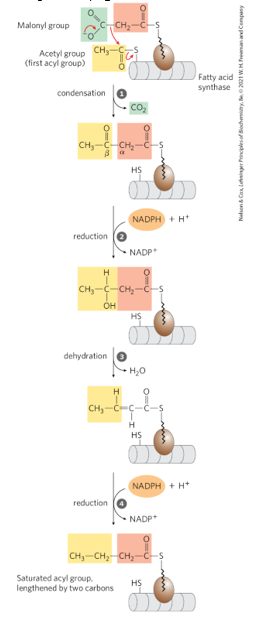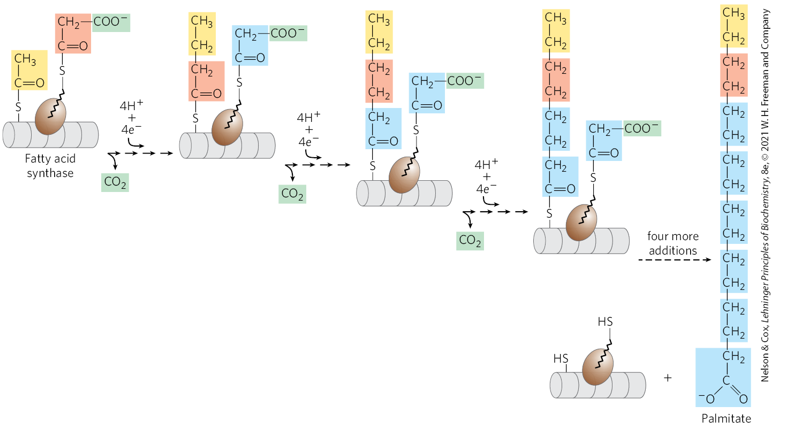Describe the reactions that lead to the addition of 2 carbons to a growing fatty acyl chain.

Describe the reactions that lead to the overall process of palmitate synthesis

Be generally aware of the location of lipid metabolism in mammals and plants.
Mammals: In mammals, fatty acid synthesis takes place in the cytosol while fatty acid degradation takes place in the mitochondria. Fatty acids must be shuttled into the mitochondrial matrix by the carnitine shuttle, whose transporter is inhibited by malonyl-coA, the first intermediate in fatty acid synthesis. By keeping these two processes seperated, it prevents the simultaneous degradation and synthesis of fatty acids, which would be a futile cycle.
Plants: In plants, fatty acid synthesis occurs not in the cytosol, but in the chloroplast stroma where NADPH levels are high (produced in light-dependent reactions of photosynthesis).
Understand how fatty acid biosynthesis is regulated and how the body knows when to make fatty acids and when to consume them.
1. The reaction catalyzed by acetyl-CoA carboxylase is the rate-limiting step in the biosynthesis of fatty acids (converts acetyl-coA to malonyl-CoA). Activators: [citrate]. Inhibitors: [Palmitoyl-CoA]product, [glucagon, epinephrine, high AMP] trigger phosphorylation/inactivation
2. Acetyl-CoA carboxylase of plants is activated by an increase in stromal pH and [Mg], which occurs on illumination of the plant.
3. These pathways are also regulated at the level of gene expression. When animals eat an excess of polyunsaturated fatty acids, the expression of genes encoding enzymes is suppressed. This is mediated by a family of nuclear receptor proteins called PPARs.
4. Beta oxidation is blocked by malonyl-coA, which inhibits carnitine acyltransferase 1.
Be able to describe the difference and similarities between the synthesis of Triacylglycerides and glycerophospholipids. You should be aware of the structures of both and from what starting materials they derive.
1. Both TAGs and GLP are derived from 2 fatty acyl-CoA and G3P. These compounds turn into phosphatidic acid, from which the two compounds are derived.
2. TAGs: Phosphatidic acid forms into 1,2-diacylglycerol from the enzyme lipin. This compound is converted into TAG by acyl transferase.
3. GLP: attachment of head group to phosphatidic acid
Know where glyceroneogenesis takes place and what reactions are involved with the process are, and the reason for this pathway in the body.
1. Takes place in the adipose tissue
2. Pyruvate (Pyruvate Carboxylase) -> OAA (PEPCK) --> PEP --> DHAP (G3-P DH) --> G3P --> TAG synthesis
3. Multiple reasons for this pathway: Helps control the rate of fatty acid release into blood, controls the rate at which free fatty acids are delivered to mitochondria for use in thermogenesis, supports the synthesis of G3P in fasting humans.
PEPCK limits the rate of synthesis, regulated by hormones cortisol and dexamethasone.
Be familiar with the fates of cholesterol and the various roles that cholesterol plays in the body.
Fates of Cholesterol
1. Bile Acids. Principal components of bile, excreted into small intestine to aid in digestion.
2. Biliary cholesterol. Contained in bile in much smaller amounts.
3. Cholesteryl esters. Formed in the liver through the action of acyl-CoA-cholesterol acyltransferase. transported in secreted lipoproteins to other tissues that use cholesterol.
Cholesterol is the basis for steroid hormones. It also is used to maintain the integrity and fluidity of the cell membranes to serve as a precursor for the synthesis of substances. It serves as a precursor for the synthesis of substances that are vital for the organism including steroid hormones, bile acids, and vitamin D